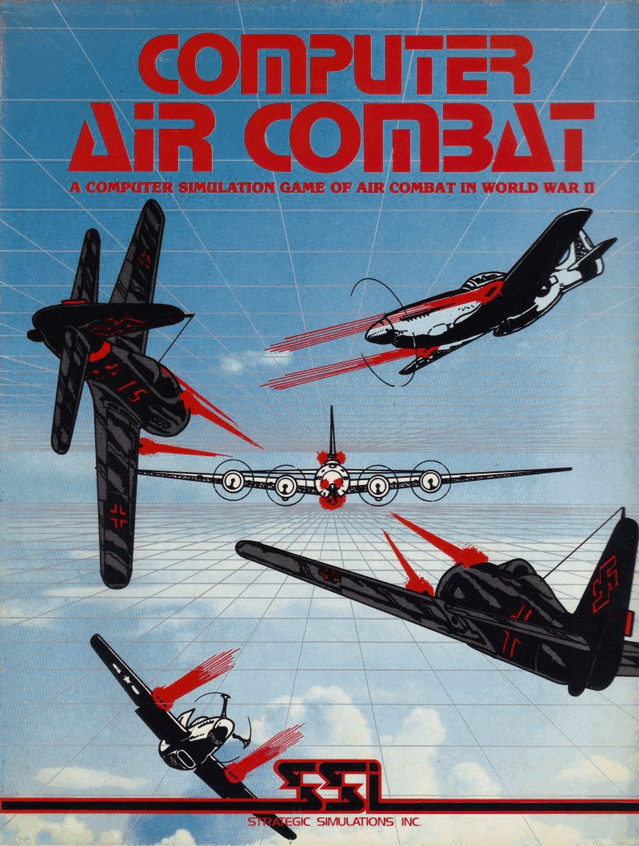
Computer Air Combat by Charles Merrow and Jack T. Avery , published by Strategic Simulations, USA
First release : November 1980 on Apple II
Tested on : Apple II Emulator
Total Hours Tested : 10
Average duration of a battle : 1-3 hours
Complexity: High (3/5)
Would recommend to a modern player : No
Would recommend to a designer : No
Final Rating: Flawed and obsolete
Note that all reviews and ratings assume you have read the After Action Report. This review was updated on 03/05/2022 with new information from Joel Billings, correction on the manual content and conversion of the rating to my new system.
If you want to simulate air combat in the late 70s, you have two routes :
- The novelty route : computer games. Game designers immediately saw the potential of computers to emulate air combat, starting with the arcade games Pursuit by Kee Games in 1975 (now lost) and Interceptor in 1976, by Tomohiro Nishikado (of Space Invaders fame). Of course, I cannot say for Pursuit but Interceptor was more faking it than making it.
By 1980, the technology, while primitive, was there. FS1 Flight Simulator (1979), featuring WWI combat, was immensely popular, with according to the developer 30 000 copies sold by June 1982. For comparison, Computer Bismarck was a success for SSI at 8 000 copies sold. Yet, those games were at the same time among the most complex to code, and not quite satisfying :
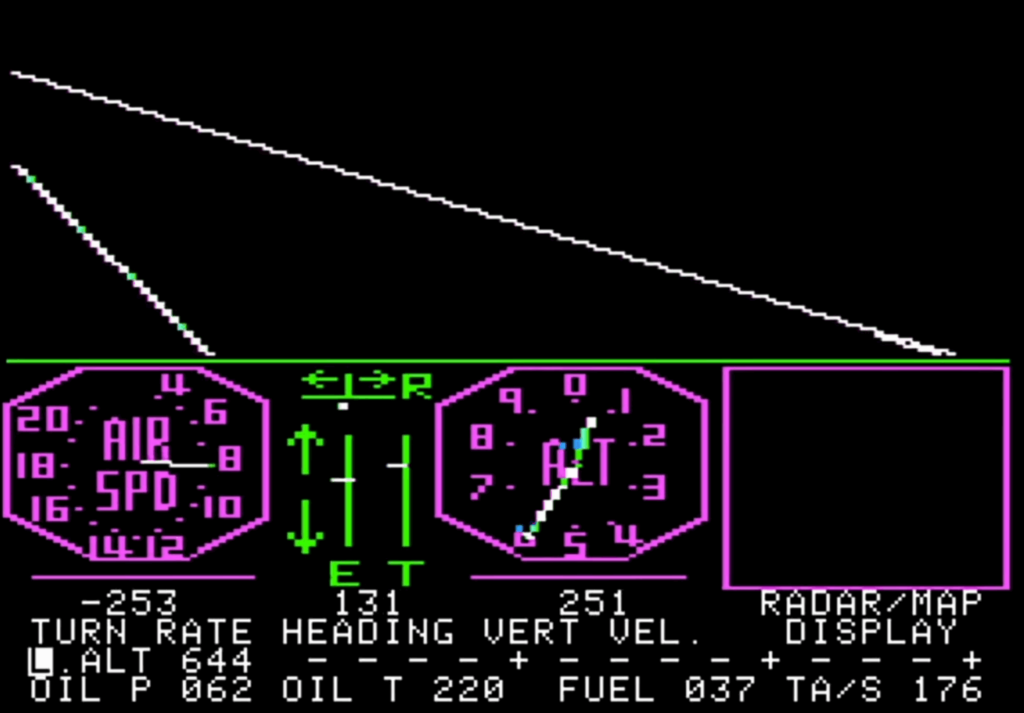
- Else, you could go for the traditional “tabletop” route, turn-by-turn and top view – not necessarily less immersive given how poor computer graphics were in that era. There were in the 60s and 70s a lot of air combat wargames : Dogfight (1962), Richthofen’s War (1972), Sopwith (1972), Air Force (1976), Air War (1977), Ace High (1980), … Those games usually shared three features :
- They were pretty complex, with many rules to manage every turn,
- While complex, they still streamlined a lot of things, in particular anything related to altitude,
- In many cases they represented WWI rather than WWII (or later conflicts), as the more limited capabilities of WWI planes are easier to simulate with rules that humans can understand.
I suspect that for many players, these were the kind of games that you owned, maybe of which you played an introduction scenario, and then shelved while hoping that, one day, you would find the partner to play with. Or maybe I’m projecting my own relationship to Great War at Sea : Jutland.
Computer Air Combat is the first to offer a third route : leveraging the computer’s calculation power to not only remove the rule management problem, but furthermore offer a complex, realistic simulation that would still be managed effortlessly by the computer. Being able to simulate WWII was the cherry-on-top. Of course, the fact that the player did not have to referee at the same time did not make the game easy to play in any way.
The developers, Charlie Merrow and Jack Avery, were employees in the defence industry from San Diego. After playing Computer Bismarck, they realized SSI could publish the air combat game they had designed and coded on the side. Computer Air Combat was their first game, but Charlie Merrow had a lot of programming experience, Billings described him in 1982 as “having 22 years of commercial programming experience on 15 different computers”. For his part, Jack T. Avery seems to have been more the aviation expert and researcher. In any case, they contacted SSI, probably in early summer 1980. It was just the right moment : Joel Billings had been contacted shortly before by Danielle Bunten for Computer Quarterback, and Billings had realized that he could not only make games but also publish them. SSI saw the potential in Computer Air Combat and unlike with Computer Conflict they went all-in. The game included :
- A manual, including historical background,
- Four reference cards : one describing the scenarios, one with the game commands, two with the stats of the planes
- A sky chart, to take note about which enemy you spotted, of course I do not believe anyone earnestly thought it was useful – but it was cool and looked serious,
Initially, Computer Air Combat offered 36 planes from United States, United Kingdom, Germany and Japan – Soviet Union missing is a bit of a surprise.
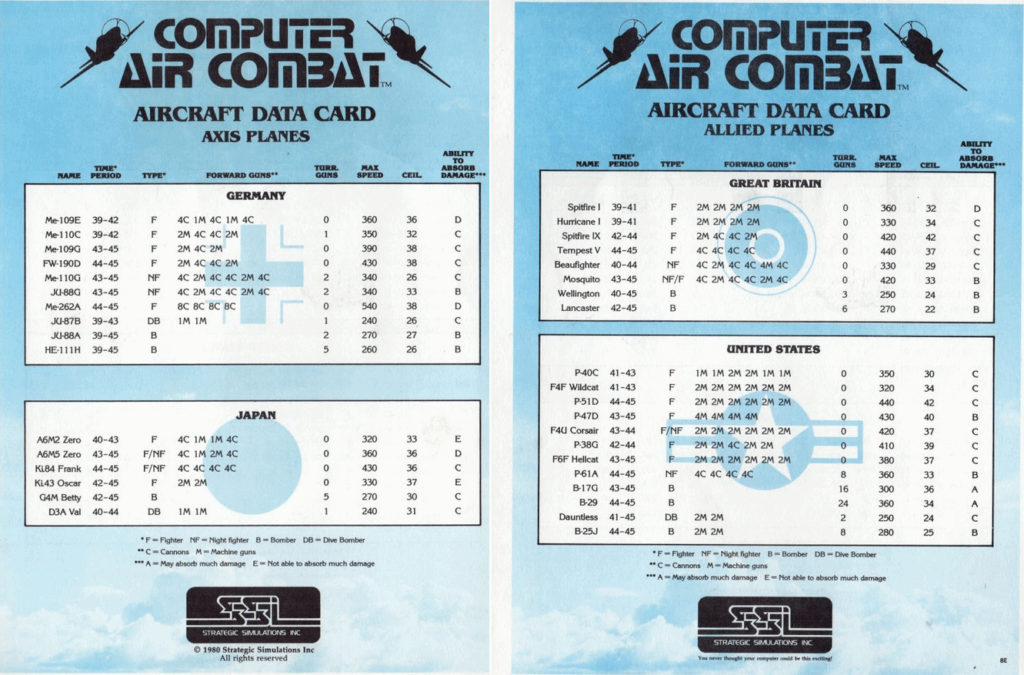
This would be corrected. I believe that Computer Air Combat, along with Computer Quarterback, would innovate in another way : they are (to my knowledge) the first computer games to offer not sequels, but expansions. I am not sure exactly when it was released, but it is there in the Winter 81-82 catalog :
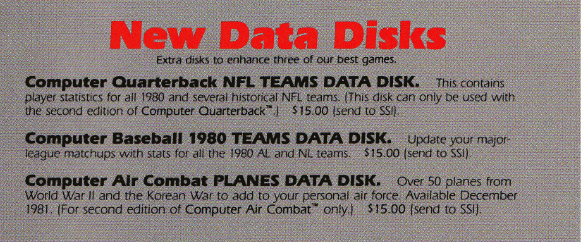
As I have said in the AAR intro, the Data Disk would add German, Russian, Romanian, Polish, Italian, North Korean and “United Nations” planes , for a total of close to 60 new WW2 planes and 12 specifically Korean War planes. The update created the amusing situation that the Japanese Air Force (6 planes) has a less impressive line-up than Finland (10 planes – more than UK) or Romania (7 planes). Of course, France missing feels strange when Poland is there with 3 planes, though the 1939-1940 French planes that mattered have been allocated to Romania anyway.
That was a long intro, what did I think of the game ?
A. Systems
Starting with systems, because this is the most complex game I have reviewed so far.
The game is turn-based, with simultaneous resolution, and two phases : Movement phase and Combat phase.
- The movement phase represents 7 real-life seconds, which as we saw in the AAR allows to quickly calculate what distance in feet (the game unit for distance & altitude) will be traversed in the period (100 mph = 1000 feet in 7 seconds). During his turn, the player plots what the plane will be doing during those 7 seconds.
This distance will also be used as “action points” of sorts, in that every action will be executed after the distance has been traversed (during the 7 seconds frame, or from one turn to another).
Let’s take for instance this Wildcat, going 200 mph :

If I “check its capabilities” [CK] I receive the following information :

It says that Rolling Right [RR] or Rolling Left [RL] will take me 700 feet and that moving the nose up [NU] or down [ND] will take me 300 feet.
So let’s do two actions at the same time : rolling right [RR] while moving the nose up [NU] :

After having given those orders, I ask the plane to go straight ahead [ST] for any distance, for instance 300 feet.
And after I moved 300 feet, my NU order is executed and my nose is now pointing up [H1].

And going straight ahead again until the next maneuver is done, I am now rolled right – I traversed 700 feet out of 2 000 I can plot this turn.

After that , I can check my capabilities again :

Since I am now rolled to the right, I can now turn to the right [TR] or slide to the right [SR]. If I turn to the right, I will not finish the maneuver before the end of the turn, so it will be carried over to next turn.
This seems pretty easy, but this is only because we started from level position. In practice, it can become quickly complex. For instance, quoting the manual :
5.61 Climbing
The nose of your aircraft must be in the H1 or H2 nose attitude in order to gain altitude by climbing. Aircraft in a steep bank attitude, R2 or L2, can only climb if in H2 nose attitude; for them the H2 attitude is like H1 , and H1 is equivalent to LV. The H1 attitude is used for normal climbing, while the H2 attitude is used only to trade speed for altitude in a “zoom” climb, or to enter a climbing half-loop. Inverted aircraft may not be in an H2 nose attitude. […] Aircraft which spend more than half a turn in an H1 nose attitude must climb at least 0.01 kft, unless they are in a steep bank attitude. For purposes of making this determination, time spent diving will offset time spent climbing. Maximum climb ability while in the H2 attitude is increased by an amount which depends upon the speed and type of aircraft.
I am pretty sure you either skipped this text by the 4th row, or read it at least twice before understanding it.
The manual is pages and pages like that, and yes I understand that it is logical that for instance a plane nose down with a strong bank on one side or another [R2 or L2] will turn 45° if it pulls ups, but it is not because it is logical in real-life that it is easy to remember when playing.
Anyway – after you have finished plotting your movement, you have to choose your new speed and by how much you climbed and dived – of course this will all depend on your current speed/altitude/nose orientation, and then it is combat phase.
- Combat phase is simpler : anything in front of the gun in a cone of angle 45° and length 2500 feet is in range ; your chance to hit depends on how far it is and on its “aspect” (=direction compared to you). You shoot with all your guns, which have limited ammo. There are also defensive guns (typically on bombers or on heavy fighters) with unlimited ammo. Damage is allocated to wings, fuselage, cockpit and engine. Too much damage and the plane is shot down.
This brings us to the core issue of the game : the fact that you can only shoot at things that are at 2500 feet of you every 7 seconds. Any speed differential of more than 250 mph (typically, two planes in a frontal pass, or just one plane buzzing perpendicularly) and two planes that in real life should be able to shoot each other will not be able to. I tested planes from all the available periods – in early WW2 it is already bad but in the Korean war where the planes can easily reach 600 mph this is just terrible for gameplay. I tried in particular a 2vs2 dogfight opposing Mig-15 to F-86E, after 80 turns (aka 2 hours of my time) of planes trying to shoot each other I just quit.
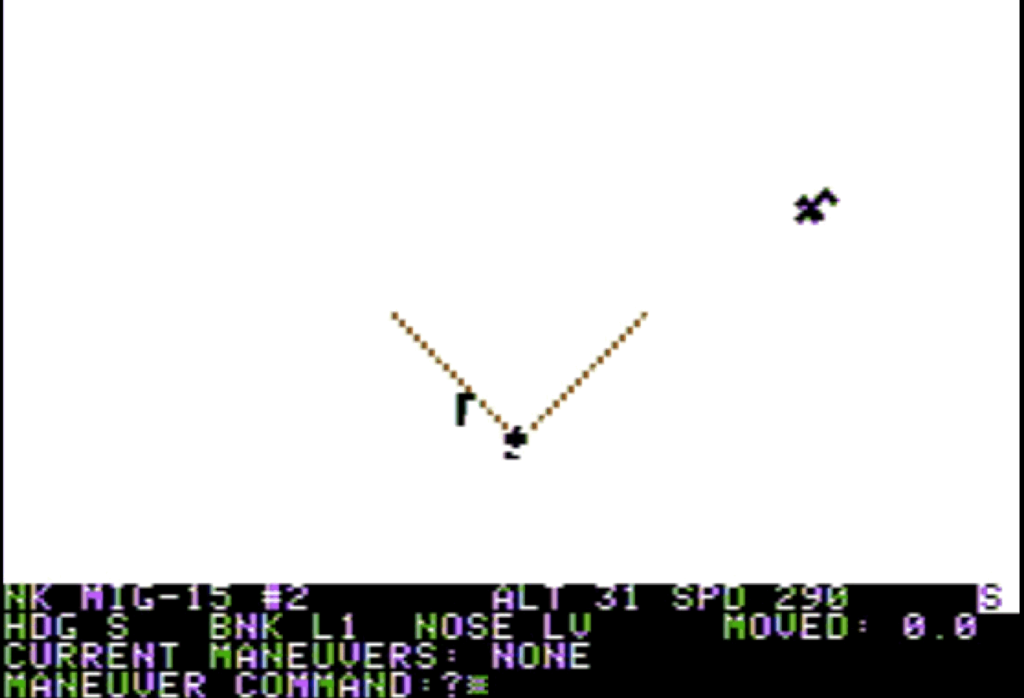
Add to this that you can only do 45°, so it is extremely common to have 2 planes that are slightly parallel and cannot reach each other quickly because what they would really need is turn 20°. This could have been solved by allowing the slide manoeuvre to move the plane a lot more than 100-300 feet on one side or another.
Long story short : the system was designed to be realistic, but a few design choices made it very unrealistic, and very frustrating.
Score : Average
B. UI , Clarity of rules and outcomes
Starting with the UI, as per my AAR the camera is either too far away (for the Global Plot) or too close (for the Tactical Plot). Worse, once in the Tactical Plot you cannot check again the Global Plot or even the Position menu with the list of all planes. Given that in the thick of battle your planes are flying in all directions, by the second or third plane there is a good chance that you don’t remember whether THIS plane should turn left or turn right.
As for giving the orders themselves, it is not helped by the lack of feedback about the movement you already plotted (unlike in Computer Ambush), the lack of grid on the tactical map to evaluate distance (you will have to compare both planes’ X and Y coordinates, if your target direction is at a 45° angle compared to you, you are also going to have to do trigonometry on the fly). It would already be a bad experience in 2D, so now imagine with planes at different altitudes pointing their nose up or down, and not being able to be wrong by more than 2500 feet if you want a chance to hit your target.
As for clarity of outcome, movement is perfectly deterministic, but combat is not, and you have NO idea what are your odds of hitting your target. Given ammunition is limited, this is really not a wise decision in my opinion.

On the positive side, the manual is very complete, even if hard to understand if you don’t have the game in front of you – but then there are training scenarios for a reason. It also includes specific descriptions of each aircraft, including in which direction the weapons can shoot.
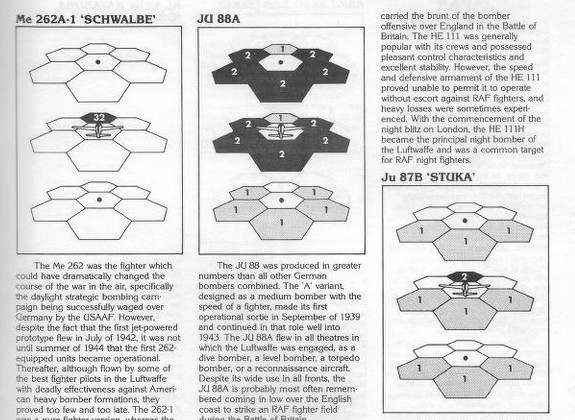
Score : Average
C. Settings & Aesthetics
Well, aesthetics is the easy one. Almost none, though I am impressed that I could tell how a plane is banking when it is drawn with maybe 5×5 pixels.
As for settings, as frustrating as the rules are, I must admit that as long as no one is shooting it really feels realistic and immersive, an immersion that is broken every time you actually try to shoot a plane.
There are plenty of more minor rules that add to realism : it is possible to land and take-off, though landing, in particular, has no purpose in any scenario. You can decide that your planes have extra fuel tanks, which will hurt their performance, but let’s be serious you will immediately dump them at the beginning of the battle. The game will tell you whether the crew of a downed plane managed to jump out. You will sometimes lose sight on the enemy (especially when he is behind you), though usually one strong turn and you will see it again. Those are nice and immersive features.
The number of planes is impressive, and they really feel different when you pilot them. I did some tests below (climbing rate and turning distance), with 3 planes, at different altitudes :

Despite having nominally almost the same stats as the Wildcat in the reference card, the Zero is a way better climber, while the Wildcat turns better. As for the MC200, at low altitude its reputation of excellent turner is there in the game, but it loses a large part of its advantage at higher altitude.
The historical / aircraft description section at the end of the manual is a joy to read – I read it all when commenter JKlas uploaded the manual on archive.org, long after I had finished the game. It really shows the attention to detail Merrow and Avery had for their game.
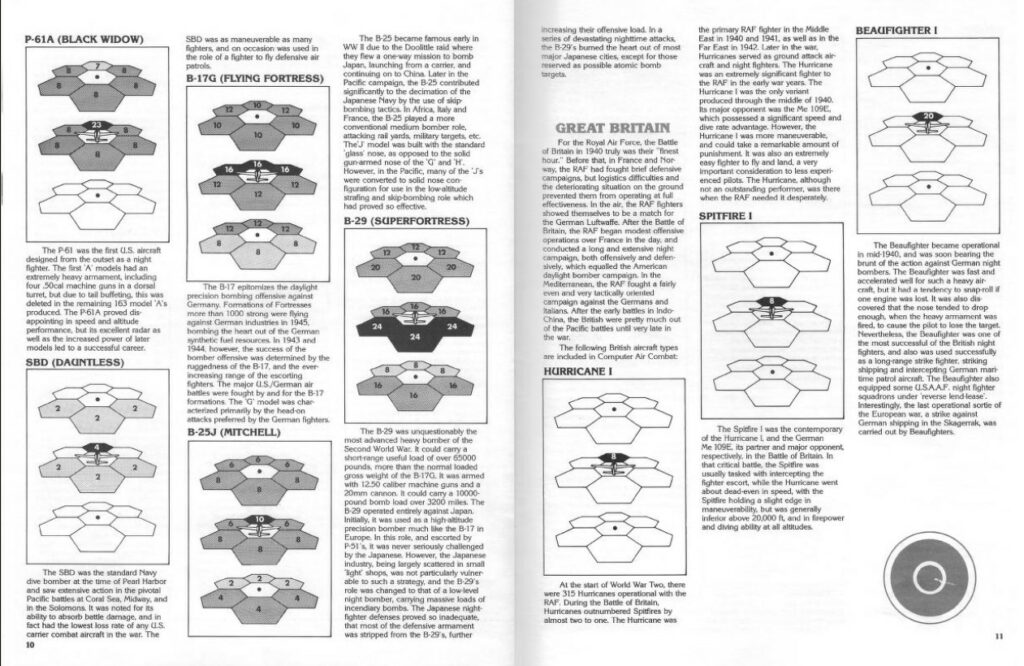
The data disk is on par, with similar historical tidbits about the minor countries :

Minor complaint : the Romanian plane line-up is incorrect, featuring planes they never flew (Dewoitine 520 ? They wished ! Morane-Saulnier 406 ? They escaped that) – but I appreciate the effort. In the 80s Romania was just seen as that country that lost the Stalingrad battle for the Axis, and I suspect material about the Romanian Air Force was extremely rare.
Score : Average
D. Scenario design & Balancing
As we have seen in the AAR intro, there are 5 scenarios :
- Air Race has no specific interest in single player except to test planes, it could be amusing in multiplayer, if you manage to find friends who like this sort of thing, a challenge in itself,
- V1 Interception is something you are only going to play exactly once, and can be considered a training scenario,
- Night Fighting is also a good training scenario, against targets that can defend themselves but do not maneuver too much,
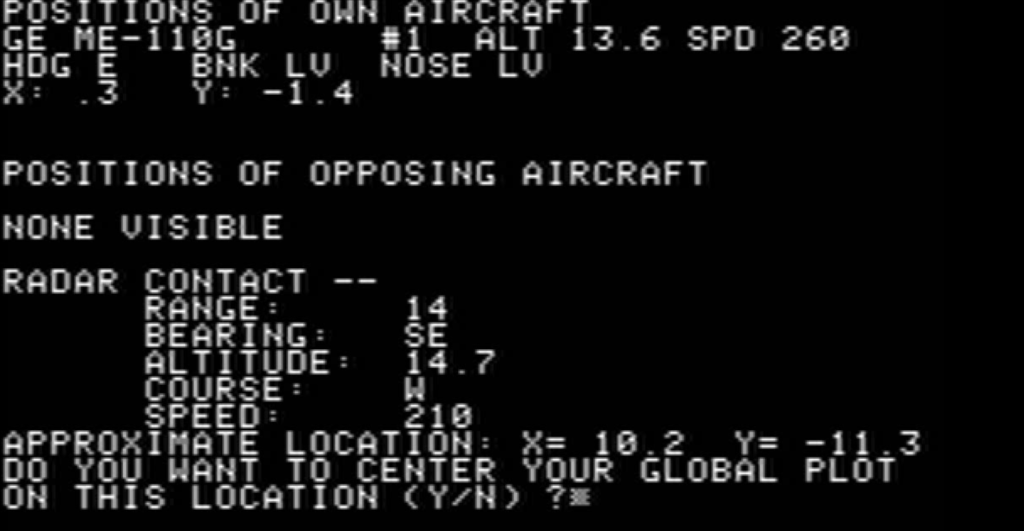
- Bomber Intercept is by far the best scenario, as it forces you to make tactical decisions (go for the bombers directly, or try to shoot down the escort first) and due to the limitations of the game shooting down bombers is easier and more “fun” than shooting down fighters,
- Dogfight is tedious due to how hard it is to anticipate fighter movement. I appreciate that you can create “scramble” mission where some of the planes are on the ground and cannot take-off until their enemy is detected,

You can customize your scenarios freely, with the data disk you can even mix countries (US and Japan against Germany and North Korea ? Why not !)
On the other hand, the scenarios are all pretty dry : no weather, no sun, no ground attack, …
The AI is challenging enough, though I noticed that with the fast Korean War planes it stalled quite a lot. For your WWII games it will not happen.
Score : Average
E. Fun and Replayability
I am sorry to say, but as much as I wanted to like the game, I did not have fun. I played several hours hoping that once I reached some level then I would like the game, to no avail.
And yet I am not a stranger to air tactics simulations, I played and liked Avalon Hill’s 1997 Achtung Spitfire! for instance, but Computer Air Combat is just too arid, you need to calculate too many things on your own every turn, and your best manoeuvres keep getting cancelled by because the rules of the game won’t let you shoot at your target.
It is of course hard to talk about replayability of a game you did not like much in the first place. In my opinion it has some replayability, but without long term objectives, all the battles will kind of look the same after a while, even to the aficionados.
Score : Poor
F. Final rating
Flawed and obsolete. It is a game I respect a lot, but not a game I like.
Contemporary Reviews
Computer Air Combat is a peculiar animal in video game magazines. It is almost always mentioned as part of the story of SSI, or in any compendium of wargames, but good luck finding a review for it – I suspect that most reviewers were in my situation : no love for the game, but deep respect and for this reason not willing to write a negative review for it.
There is one exception though : Dale Archibald in November 1981 in Creative Computing. It takes him several columns to explain how the game works, but it looks like he had fun (he says he had a “mania” for a week, he also ran more ambitious scenarios than me : 5 vs 5 !). He also praises how fast turn resolution is compared to other SSI games (2 minutes only !) and concludes “one of the finest game I have yet played“.
Beyond that, I found maybe a couple purely descriptive reviews of the game (eg in January 1983 in Video Games). And that’s all.
I feel like this game is like Proust’s In Search of Lost Time (or James Joyce’s Ulysses for you Anglo-Saxons) – everyone has heard of it, many like to pretend they played it, but deep down we know almost no one played it and those who did mostly did not enjoy it. In any case, the game sold 4341 copies, a good performance in 1980 – Computer Conflict released at the same time only sold 2433.
Interestingly though, the game was re-released on Commodore 64 in 1985 under the new name “Wings of War“, selling 2909 additional copies.
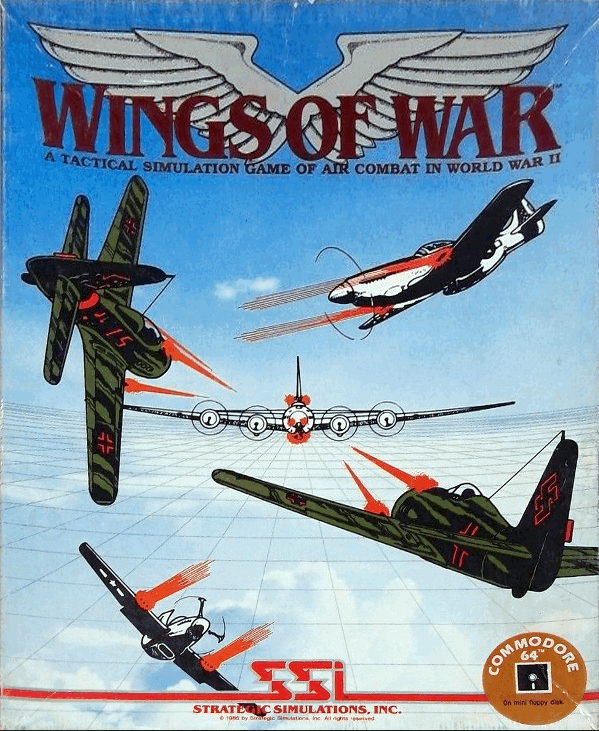
This re-edition under a new name though would give me a final proof that almost no one really played Computer Air Combat ; in their 1991 retrospective on wargames, Computer Gaming World would cover both, with pretty different comments :

So, much like French wine getting panned at international blind test competitions when the label is hidden, the same game received a much poorer review when it wasn’t presented under the revered name of Computer Air Combat.
Charles Merrow and Jack T. Avery carried on working with SSI, and developed Computer Baseball in 1981. Computer Baseball became the best seller of SSI at 45 000 copies, a record that was not beaten until Gemstone Warrior (1984) and Phantasie (1985) sold respectively 52 000 and 54 500 copies. We will see Charles Merrow and Jack T. Avery again with their 1985 Fighter Command: The Battle of Britain – Joel Billings told me it was one of his favourite wargames so I am looking forward to it.
12 Comments
I’m more of a role-player person than a wargamer, but in both cases you can feel the eagerness early computer game players had to engage as fully as possible with the software available to them.
Today we’d just click and drag where we want the plane to go, perhaps, but someone had to sit down and plot their planes’ location and altitude manually (and laboriously!) and they probably enjoyed doing it. That’s a world we simply don’t live in any longer.
Having read contemporary reviews of SSI games, I am not sure any more that wargamers of the era were that different, except in that they had very few alternatives.
I am now playing Torpedo Fire, where you have to calculate angle and distance at which you shoot some of the weapons, with the added complication that ships can go at all 360 degrees (not 45d increments) and that depth charges and similar sink at 10 feet / second- so there are some non-trivial calculation to try to hit submarines. I guess someone with a more solid math background than me will like this kind of calculation, but that can’t be a lot of people and in any case it is a bit too complex both me and most contemporary reviewers.
Yeah, they loved that stuff. The more complicated the game was, the more realistic it was, the thinking went. There was also nerd pride in being able to simply play such a complicated beast. This was the era of the “monster game” – initiated with GDW’s Drang Nach Osten, with 1,792 playing pieces and 200 hours play time.
Wargamers ate it up, even if most of them never finished a game. Computerization offered so much promise – even *more* complicated rule sets, which could be refereed by a computer which never forgot a phase or to apply a corner case rule. It is said that there has never been a game of Advanced Squad Leader played entirely according to the rules. And *no* rules arguments, ever.
And then the holy grail – a computer opponent. Someone to play with, since it was always a pain to find someone to agree to sit down with you for 200 hours. If you were at a university and didn’t have to work, it was heaven, but otherwise tough. What were you going to do if you were in to WWII but the only wargaming group near you did ancients with a break for pike & shot sometimes?
But did anyone really play Drang Nach Osten, or did they just look at the counters with wet eyes and imagine how fun it would be ? Even at University I had troubles organizing 6 hours long diplomacy games, so 200 hours play time – no way. At best the “small” scenarios, like I did in Jutland [“Russo-Swedish war in 1914 ? Manageable”
I sure played the heck out of CAC in the day. This was basically Avalon Hill’s “Air Force” on the computer.
In the early 90s I put a couple of scenario disks out in Usenet world that I still keep looking for. I’d hacked things a bit to include some experimental enhancements – a Taranto scenario used grounded bombers in place of ships. The second disk was a Japanese campaign based on Sakai’s Winged Samurai. If anyone has them do please let me know.
I agree with your ‘wet eyes’ comment on the monster games. Many do I have with the counters still unpunched after 30+ years .:) But we did play them sometimes, it was more just about getting together and playing with the system for a bit, not actually finishing them. Same with diplomacy, we’d play every Thursday for about 3 hours and then head to the pub and try to make friends again. Never finished a game that wasn’t PBM.
The quintessential monster still Campaign for North Africa. I’ve played only half a turn of that at the micro level recording every move and dice roll. There’s a session report I dropped on BGG that is about 100 pages long. Slogging through a full game is not at all interesting, but half a turn was enough to get a good feel for how much of it worked, and let me dry my wet eyes on that purchase. 🙂
Interesting testimony about what was the game back then. I am really surprised the game still had enough clout in early 90s that you put scenario disks on usenet. On the other hand, when you like a game, boy can one get creative. My bro and I had a whole “football” ruleset with asteroids in Star Control II
Do you have the link to that 100 pages long AAR for half a turn ? I am interested :).
Not so much that it still had clout in the 90s but it was the days of the great 8-bit retro revival. Internet was new. More folks moving over from BBS world with 14.4k dialup modems, usenet was new, no www. Emulators like applepc and applewin came along and the ftp site at asimov was born. And with the mcfadden (ciderpress) and mulron rdos cracks there came the ssi games and the possibility to play these much loved games again by email with savestates.
No pdf manuals but for apple game docs there was a little site called textfiles.com that was put together by the guy that now runs archive.com.
It’s been wonderful to find that many Usenet archives from the 90s are now accesible. Take a peek at something like comp.emulators.apple2 on google groups.
Here’s the CNA link:
https://boardgamegeek.com/thread/1756003/cna-solo-session-first-opstage-detail
!! And I did manage to locate a partial copy my first scenario disk in old archives, with a nice manual too. I’ll post files if any of this is at all interesting. Also fo7nd 3 games worth of CAC playtest emails with the guy that ran A2War. Months of ‘dakka, dakka, got you schwein!’but fun reading for me. Computer Ambush too. You out there slowrider, old friend?
Incidentally, the way we played was a 20 turn limit, with the last turn variable. So game could be called from turns 18 to 23. Points awarded based on damage, or by scenario.
Post that stuff. The audience for this game will find this blog entry, and follow your links if they’re interested to try.
Attached should be CAC Scenario Disk #1. Side A only one that I could find I’m afraid.
There’s a detailed manual to accompany.
Here’s a summary of the 5 scenarios on this disk, and also details of what was on Side B, and Scenario Disk #2.
Computer Air Combat (SSI)
Scenario Disk #1 – Side A
Meeting Over Metz (29 March, 1940)
The Battle of Britain (August, 1940)
The Defense of Greece (November, 1940)
Attack on Taranto (11 November, 1940)
The Battle of Midway (4 June, 1942)
===================
Scenario #1 — Meeting Over Metz
This scenario depicts the first combat between the Hawker Hurricane and the Messerschmitt Bf-109. On March 29, 1940, three Hurricanes of No. 1 Squadron encountered two ME-109’s of JG 53 near Metz. Flying Officer Ritchley scored the only kill, downing one German. These two aircraft would meet many more times before the issue was decided.
===================
Scenario #2 — The Battle of Britain
Before being shot down on January 28, 1942, outside Boulogne, Dick Tuck, D.S.O., D.F.C., tallied 30 kills officially, 36 by his own count. He survived German POW camps until January 1945 when he escaped to Russia, then escaped from the Russians to the British Embassy in Moscow.
In August 1940, a section of 92 Squadron led by Tuck intercepted three Ju-88’s eight miles north of Cardiff. Although one Spitfire was quickly put out of action by a bullet in the radiator, the remaining three destroyed the invaders, Tuck personally flaming two.
===================
Scenario #3 — The Defense of Greece
No one knows how many Marmaduke St. John Pattle of the RAF scored during World War II. Estimates range from 28 to over 40.
In 1940 Pattle was a member of 80 Squadron stationed at Sidi Barrani, Libya. In November, the squadron was sent to Paramythia in northwest Greece near the Albanian frontier to oppose the Italian invasion of Greece. This hypothetical scenario depicts a typical encounter between 80 Squadron and an Italian bombing mission.
===================
Scenario #4 — Attack on Taranto
On November 11, 1940, 21 Swordfish from the carrier Illustrious struck a telling blow to the Italian fleet anchored at Taranto. The first wave, commanded by Lieutenant Commander Williamson, consisted of six Swordfish with torpedoes and six with bombs and flares. While the bombers made a diversionary attack on shore installations and smaller ships, torpedoes struck the battleships Conte di Cavour and Littorio. The second wave hit Littorio again and Caio Duilio. As a result of this attack, Conte di Cavour was put out of action for the war’s duration and Littorio and Caio Duilio were disabled for six months.
Of the 21 attacking aircraft, only two were shot down with the loss of only one crew member. Less than 13 months later, the Japanese naval air arm would again demonstrate the vulnerability of a fleet at anchor.
===================
Scenario #5 — The Battle of Midway
Accounts of the Battle of Midway rightly dwell on the successes of American carrier-based aircraft, but to a large extent these successes were made possible by Marine Air Group 22 based on Eastern Island, the smaller of the two islands comprising Midway. Equipped with seven F4F’s, 19 SBD’s, 21 F2A’s and 17 Vindicators, Air Group 22 was ordered by Nimitz not only to defend its airstrip but to attack the Japanese carriers.
On June 4, 1942, 12 fighters of A.G. 22 intercepted 13 Japanese carrier-based bombers west of Midway but were bounced by escorting Zeros, suffering the loss of nine fighters with two more badly damaged.
Despite these losses, the tenacious defense of Midway convinced the Japanese that a second strike was necessary. This in turn led to the now-famous indecision by the Japanese which allowed U.S. naval dive bombers to catch their Japanese counterparts on the deck. The rest, as they say, is history.
===================
===================
Computer Air Combat (SSI)
Scenario Disk #1 – Side B
Night Mission Over Hengyang (20 July, 1942)
New Guinea Sweep (5 March, 1944)
Debut of the Superfort (26 April, 1944)
Escape Over Falaise (June, 1944)
Last Blood for the Fifth (14 August, 1945)
===================
Scenario #6 — Night Mission Over Hengyang
On July 30, 1942, Major John R. Alison and Captain Albert T. Baumber of the 75th Fighter Squadron stationed at Hengyang attempted a night interception of Japanese bombers attacking their airfield. Flying P-40’s not equipped for night combat, they nonetheless succeeded in downing four of the six intruders. For their exploit, Alison was awarded the D.S.O. and Baumber the D.S.C. Alison finished the war with ten kills in the China-Burma-India theater, making him the fifth-ranking American ace there.
===================
Scenario #7 — New Guinea Sweep
On March 5, 1944 three P-47’s of 348th Fighter Group, 5th Fighter Command conducted a sweep in the Wewark area of New Guinea. Colonel Neel Kearly, who finished the war with 22 victories, accompanied by captain William D. Dunham (16 kills) and Captain Samuel V. Blair (7 kills), flying at 22,000 feet, spotted three Nells near Dagua Strip at 500 feet. In the process of downing the bombers, Colonel Kearly was bounced by an Oscar. The Japanese fighter was destroyed, but not before inflicting fatal damage on its target.
===================
Scenario #8 — Debut of the Superfort
On April 26, 1944, Major Charles H. Hansen, piloting his B-29 over the Indo-Burmese frontier with a cargo of fuel, spotted 12 Oscars, 2,000 feet below. After the Japanese pilots studied their new adversary for 15 minutes, half of their number attacked. Twenty-five minutes later, the first combat for the Superfortress was over, the giant bomber taking eight hits and damaging one Oscar. Notice was served that the B-29 would be a formidable opponent.
===================
Scenario #9 — Escape Over Falaise
Johnnie Johnson was officially the top-scoring RAF pilot of World War II with 38 kills. A master tactician and leader, this scenario represents the only occasion on which his aircraft was hit by enemy fire.
In June 1944, Johnson and his companions had engaged the German fighters providing air cover for Axis troops in the Falaise Gap. His wingman had headed back to base with engine trouble, so Johnson found himself alone. Spotting six aircraft above him, one waggling its wings, Johnson assumed they were friendly. Only when he had climbed to within 300 feet of them did he discover his error. At the same time the Germans recognized his nationality and gave chase. Johnson finally escaped by climbing to 12,000 feet, where the supercharger of his Spitfire allowed him to outrun his pursuers.
===================
Scenario #10 — Last Blood for the Fifth
August 14, 1945, marked the last combat and the last aerial victories for the 5th Fighter Command in World War II. On that date, five P-38’s of the 35th Fighter Squadron providing cover for two rescue planes over the Inland Sea between Kyushu, Shikoku and Honshu were jumped by six Franks. Final score: four Franks downed, one P-38 lost.
===================
===================
Computer Air Combat (SSI)
Scenario Disk #2 – Saburo Sakai
Saburo Sakai was the greatest Japanese ace to survive World War 2 with 62 air claimed combat kills. This disk includes five scenarios based on his exploits as described in Samurai! by Saburo Sakai, Martin Caidin, and Fred Saito.
Sakai’s First Combat: Hankow, China – 21-May-38
Sakai Over the Philippines: Clark Field, Luzon – 8-Dec-41
Sakai and the Seventeen: Borneo – 24-Jan-42
Sakai Over Surabaya: Java – 19-Feb-42
Sakai Over Guadalcanal – 7-Aug-42
=======
Scenario #1 — Sakai’s First Combat (21-May-38)
In May 1938, the newly graduated Sakai is transferred to a fighter unit in Formosa, who rotates him to a forward unit in China. On his first mission over Hankow Air field, his escorting squadron of 15 Claudes were astounded to see 3 Russian I-16s take to the skies as the raid was commencing. The Russian fighters climbed level with the Claudes – and attacked.
“Then suddenly they were at our altitude, big, black, and powerful. Without warning – at least to my astonished mind – one of the enemy planes whipped out of formation and bore in with alarming speed at my fighter. Abruptly, all my careful plans of what I would do in my first combat evaporated.”
Saburo Sakai
“Samurai!”, Chapter 4
==============
Scenario #2 — Sakai Over the Philippines (8-Dec-41)
Saburo Sakai is trained on the wonderful new IJN fighter, the A6M2, and is then sent to join the Tainan Air Wing, part of the 11th Air Fleet. He took part in the initial strike on Clark Air Field. Due to a lack of aerial targets, Sakai brought his Vic in to strafe the field, when they were jumped from behind by a flight of P-40s.
“With my two wingman tied to me as if by invisible lines, I pushed the stick forward and dove at a steep angle for the ground. I selected two undamaged B-17s on the runway for our targets, and all three planes poured a fusillade of bullets into the big bombers. We flashed low over the ground and climbed steeply on the pullout.”
“Five American fighters jumped us. They were P-40s, the first American planes I had ever encountered.”
Saburo Sakai
“Samurai!”, Chapter 7
=================
Scenario #3 — Sakai and the Seventeen (24-Jan-42)
While waiting in Borneo before the IJN moved on the Dutch Indies, Sakai and his wingmates encountered unescorted B-17Ds operating from Java several times. They had been attacked by B-17s and did not like being under the rain of bombs. When they had encountered them in the skies, however, their Zeros did not seem able to make much of an impression on the lumbering behemoths.
“Again. Dive, roll, concentrate on one bomber! This time I caught one! I saw the shells exploding, a series of red and black explosions moving across the fuselage. Surely he would go up now! Chunks of metal – big chunks – exploded outward from the B-17 and flashed away in the slipstream. The waist and top guns were silent as the shells hammered home.”
“Nothing! No fire, no telltale sign of smoke trailing back… The B-17 continued on in formation.”
Saburo Sakai
“Samurai!”, Chapter 9
================
Scenario #4 — Sakai Over Surabaya (19-Feb-42)
After the Philippines, the Tainan Air Wing was sent to the Dutch East Indies. There was a large air battle over Surabaya, where 23 Zeros took on “50-60 P-36s, P-40s, and Buffalos” flown by Dutch, American, and British pilots in a large, messy furball.
“We reached Surabaya at about 11:30 AM, flying at 16,000 ft. The enemy force anticipating our arrival was unprecedented. At least 50 Allied fighters flying at about 10,000 ft., maintained a large counter-clockwise sweeping over the city. The enemy planes extended in a long line, composed of three waves of V groups which outnumbered us by more than two to one…”
“Sighting our force, the Allied fighters broke off their circular movements and at full speed closed toward us… Less than a minute later, the orderly formations disintegrated into a wild swirling fight.”
Saburo Sakai
“Samurai!”, Chapter 10
==============
Scenario #5 — Sakai Over Guadalcanal (7-Aug-42)
The morning of 7-Aug-42 found the Tainan Sentai at Rabaul, where they had been pulled for a few days rest. While arming and fueling to escort the daily bombing mission over Port Moresby, the Japanese naval command was stunned to hear reports of a sudden air raid and landings at Tulagi and Guadalcanal, where an airfield was being built at the southern end of the Solomons Island chain. The bombing mission was hastily re-routed and sent to hit the invasion force off Guadalcanal – 560 nautical miles away! This was the longest escort mission flown up to that point in the war. Sakai was one of the 18 Tainan pilots sent on the mission.
“Nine of us flew to Moresby, spoiling for a fight. We got one. Nine enemy fighters, P-39s and P-40s, waited for us over the enemy airstrip, willing to fight!”
“Hardly were we in sight when they broke off their circle and roared head-on against our planes.”
Saburo Sakai
“Samurai!”, Chapter 13
============
============
Well posting the files here didn’t work. I’ll have to put them somewhere else.
Here’s the cover of the manual anyway.
Hey, absolutely great. I uploaded the manual and scenario disk you sent me by email on Archives.org
Click for the link